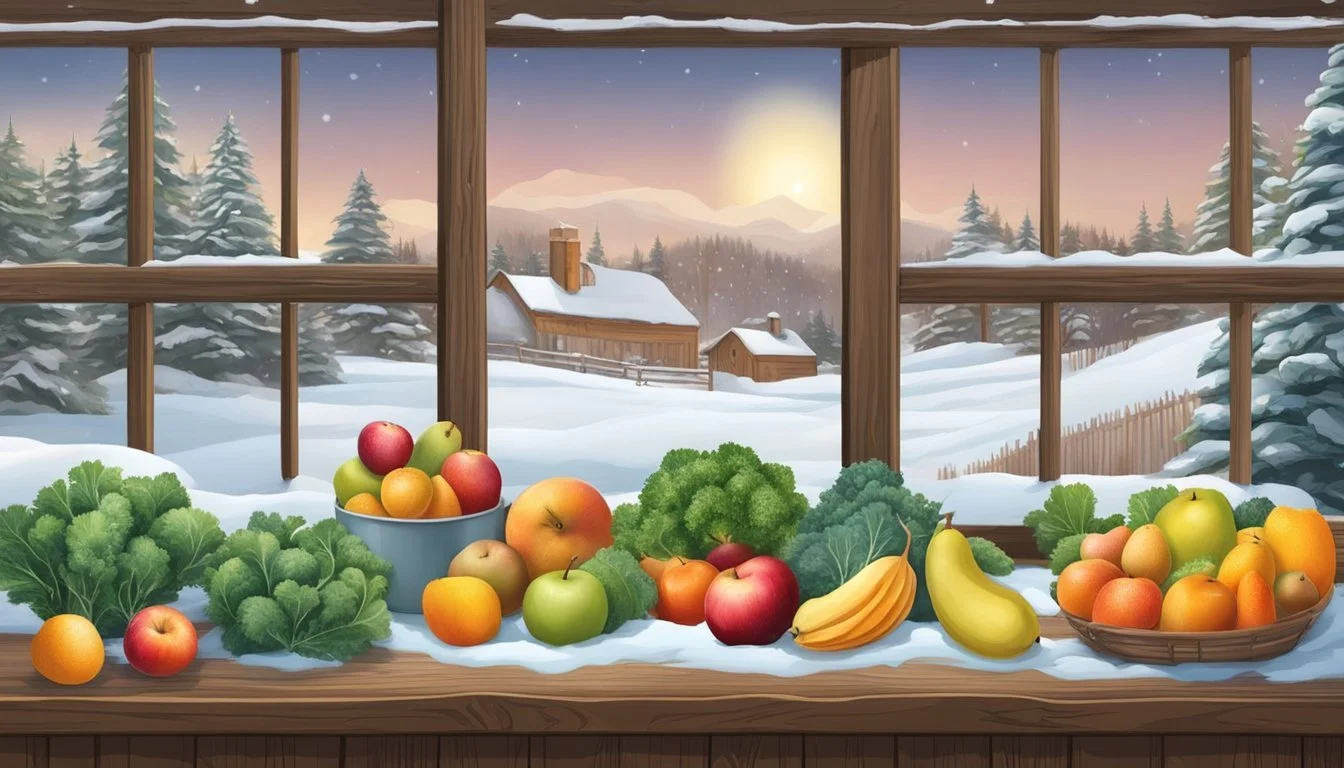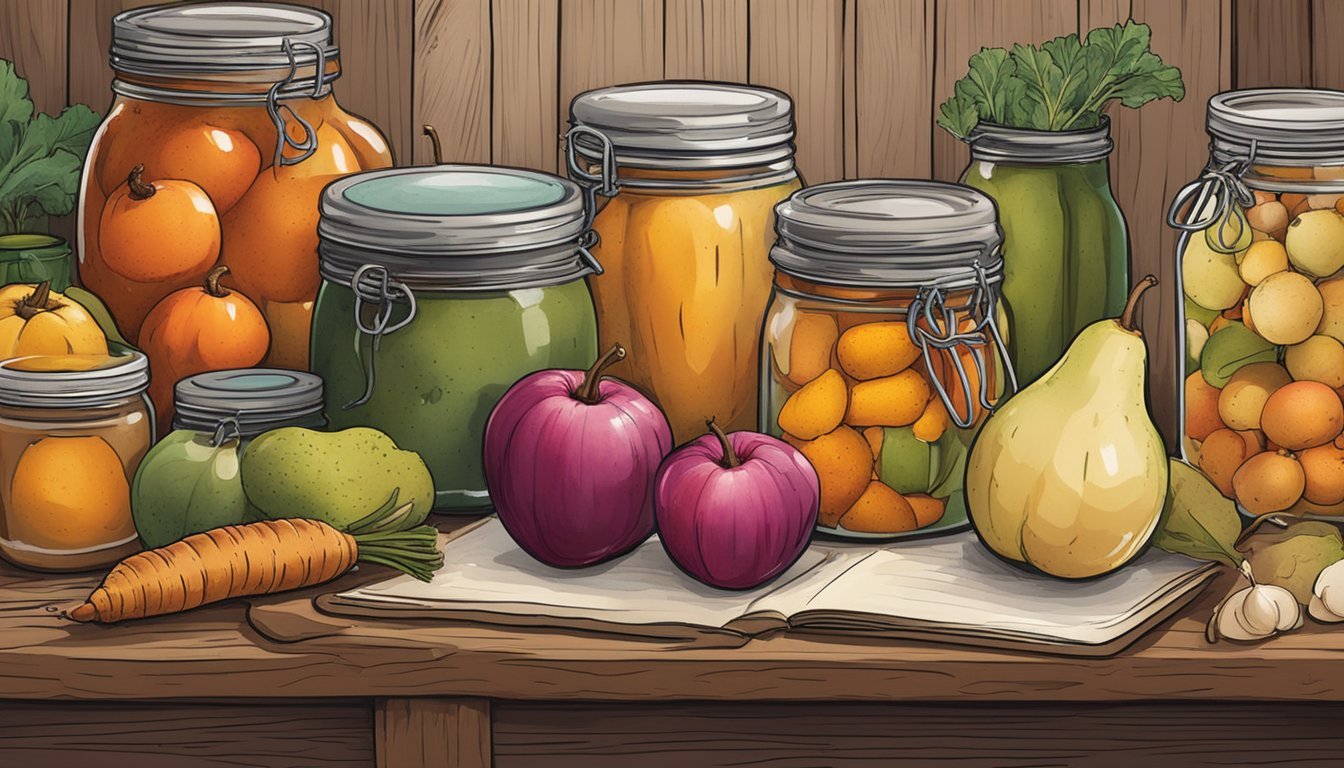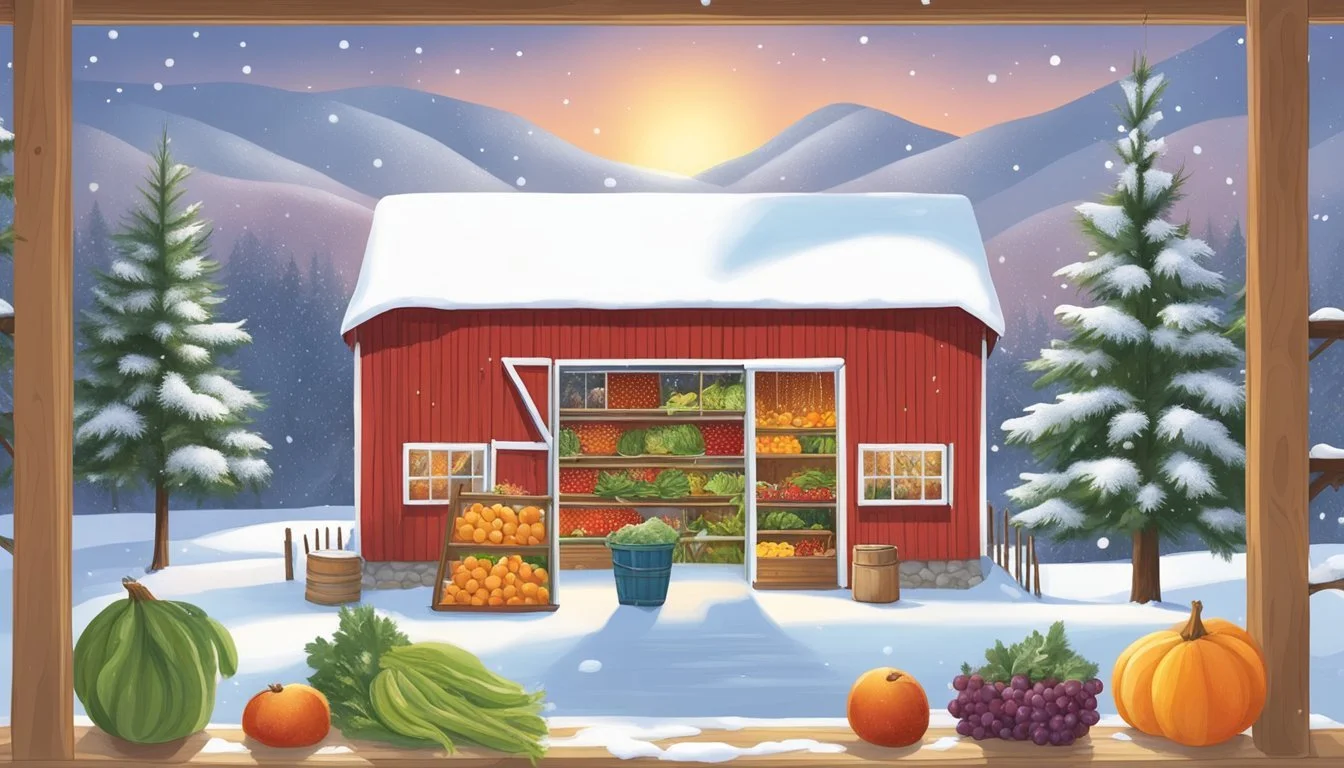Vermont Seasonal Fruit & Vegetables in January
Your Guide to Fresh Produce
This Article is Part of our Vermont Seasonal Fruit & Veg Calendar
In Vermont, January is a time when the landscape is often blanketed in snow and the climate is chilly. Despite the winter conditions, there is still a variety of seasonal produce available. Vermonters have honed the art of growing and harvesting fruits and vegetables that can withstand the colder months, ensuring that even during the winter, fresh and nutritious options are available for consumers looking to maintain a healthy diet.
The seasonal fruits and vegetables in January consist mainly of sturdy, cold-tolerant varieties. Root vegetables like carrots (how long do carrots last?) and potatoes thrive in the cool conditions and are a common harvest during this month. Hearty greens such as kale, along with cruciferous vegetables like broccoli and cauliflower, are also at their peak. These winter crops not only survive but flourish in the Vermont winter, providing a fresh burst of flavor and nutrition.
The availability of these winter-hardy varieties ensures that local cuisine can be both seasonal and diverse, despite the challenging growing conditions. Utilizing these seasonal offerings supports local agriculture and contributes to a more sustainable food system, allowing residents and visitors alike to enjoy the freshness and taste of locally-grown produce throughout the coldest months.
What Is In Season?
In the heart of January, Vermonters enjoy a variety of in-season produce that endures the cold climate. This month is known for its harvest of robust root vegetables and certain fruit offerings that peak during the winter season.
Fruits in Season
Citrus: Citrus fruits thrive in colder months. Vermont markets often feature:
Lemons
Oranges
Grapefruit
Though these citrus fruits are not native to Vermont, they are widely available and reach peak availability from other regions during January. Locally, one can find storage crops of:
Apples: (how long do apples last?) Types optimized for long-term storage remain crisp.
Pears: Later varieties are also in supply, though nearing the end of their season.
Vegetables in Season
A bounty of cold-tolerant and storage vegetables are available:
Root Vegetables: Known for their sustainability through harsh weather, including:
Turnips
Beets (how long do beets last?)
Carrots
Celery root (also known as celeriac)
Other Vegetables:
Kale: Resilient green even in snow.
Brussels Sprouts: Often available on the stalk, they withstand frost.
Cabbage: Hearty heads that improve in sweetness with a touch of frost.
Leeks: Provide a milder, sweet onion flavor.
Winter Squash: Like butternut and acorn, stored from autumn.
Each of these vegetables is celebrated for its ability to add nutritious and hearty options to winter meals.
Health Benefits
Consuming fresh, seasonal produce during the winter months can significantly enhance one's intake of essential nutrients and fiber. These foods contribute to overall health and well-being, particularly when fresh options are limited.
Nutritional Value of Seasonal Produce
In January, the consumption of seasonal fruits and vegetables in Vermont can offer robust nutritional benefits. Essential vitamins such as vitamin C—found abundantly in winter citrus—helps support the immune system and skin health. Fiber, present in root vegetables and leafy greens, aids in digestion and can help maintain a healthy weight.
Key Nutrients Found in January's Seasonal Produce:
Apples: Rich in fiber, vitamin C, and various antioxidants.
Beets: (how long do beets last?) Good source of folate, manganese, and fiber.
Cabbage: Contains vitamin C, vitamin K, and numerous minerals.
Carrots: High in beta-carotene (converted to vitamin A in the body), fiber, and vitamin K1.
Garlic: Offers allicin, linked to cholesterol and blood pressure improvements.
Onion: Provides flavonoids and sulfur-containing compounds.
Parsnips: Include essential minerals and dietary fiber.
By incorporating these seasonal offerings, individuals can embrace foods that are not only flavorful but also packed with components vital for health maintenance during the colder winter months.
Culinary Tips and Recipes
In Vermont during January, culinary creativity thrives by incorporating fresh, local produce into comforting and nourishing dishes. Here are mindful approaches and recipe suggestions to celebrate winter's bounty.
Cooking with Winter Produce
Winter's harvest commands attention to root vegetables and hardy greens, staples for roasting and baking. These methods intensify the natural sweetness and flavors of produce like turnips, carrots, and parsnips. One's cooking repertoire can benefit from these techniques to transform simple ingredients into savory side dishes that complement any main course. For a balanced meal, chefs recommend pairing these with a lean protein, creating dishes that are both satisfying and wholesome.
Soups and stews become especially popular as they offer comfort during the cold weather. Utilizing seasonal vegetables, chefs can build layers of flavor that are both rich and healthful. Crafting a hearty vegetable stew or a creamy soup can be an excellent way to utilize produce like leeks and beets.
Recipe Ideas
Salads and Slaws:
They offer a light and crisp counterpoint to heavier winter meals. Incorporate pomegranates or citrus segments to brighten a kale or chicory salad.
Recipe Suggestion: Citrus Salad with Chia-Celery Seed Dressing
Savory Dishes:
Elevate the main meal with a vegetable-filled bake or a root vegetable gratin, combining seasonal root veggies with a creamy cheese sauce and a crunchy breadcrumb topping.
Recipe Suggestion: Root Vegetable Gratin
Desserts:
Finishing the meal on a sweet note, seasonal fruits can be baked into desserts. A simple yet elegant option is roasting pears or apples with spices like cinnamon and nutmeg.
Recipe Suggestion: Spiced Roasted Pears
Salsas and Sauces:
These can perk up any dish, providing bright flavors and colors. A winter salsa might include roasted beets or sweet potatoes, adding a surprising twist to traditional recipes.
Recipe Suggestion: Roasted Beet Salsa
By focusing on these culinary techniques and recipes, one can fully appreciate the range of tastes and textures that January in Vermont has to offer.
Preservation and Storage
Preservation and storage methods are vital for extending the life of Vermont's seasonal fruits and vegetables through January. When dealing with colder temperatures, root vegetables like carrots, beets, and parsnips benefit from cellaring. This traditional method involves keeping the produce in a cool, dark, and humid environment to mimic underground conditions.
Canning is a popular technique for fruits and vegetables that allows one to enjoy the harvest year-round. It's crucial to follow strict canning guidelines to ensure safety and quality. For example, acidic fruits like apples can be canned using a water bath method, while low-acid vegetables require pressure canning for preservation.
Produce suitable for storage in a cellar or similar cool space include:
Beets
Carrots
Cabbage
Onions
Garlic
Apples
For freezing, blanching vegetables before storage will help maintain optimal texture, color, and nutritional value. Here is an example of how one may prepare vegetables for freezing:
Wash and sort the vegetables.
Cut into even pieces.
Blanch in boiling water.
Cool immediately in ice water.
Drain and dry.
Package in air-tight containers or bags.
Label with the date of freezing.
One should check on their stored produce regularly and use any items that show signs of deterioration first. Proper preservation not only maintains the nutritional quality but also reduces food waste, making it an essential practice for any Vermont local or culinary enthusiast seeking to enjoy seasonal produce outside of its traditional harvest time.
Supporting Local Agriculture
In Vermont, January's chill doesn't hinder the community's commitment to local agriculture. Through avenues like farmers markets, CSA (Community Supported Agriculture), and co-ops, residents have the opportunity to directly impact the local economy and reinforce the agricultural community.
Benefits of Buying Local
Economic Impact: Purchases made from local farms and businesses circulate money within the Vermont economy, strengthening it. This economic cycle bolsters the viability of local farms, ensures job security for those within the agri-sector, and contributes to the overall fiscal health of the community.
Community Support: Local farms rely on the community to survive the competitive market. By buying local, consumers foster a sustainable model of agriculture that enriches the community.
Freshness and Taste: Local produce often reaches consumers faster, resulting in fresher, tastier food.
Environmental Benefits: Reduced transportation requirements for local goods lower greenhouse gas emissions.
Health Benefits: Farm-to-table goods minimize the need for preservatives and offer a healthier alternative.
CSA and Co-ops Engagement: CSAs and co-ops serve as integral components in the relationship between farmers and consumers. They provide a structured means for consumers to invest in local farms, which in return offers them a share of the harvest, promoting a mutual dependence that is essential for the community's socio-economic stability.
CSAs allow consumers to subscribe to the harvest of a particular farm or group of farms, often receiving a weekly or bi-weekly box of seasonal produce.
Co-ops, owned and governed by community members, focus on sourcing from local producers, thus keeping profits within the local economy and enabling farmers to sustain their operations.
Seasonal Challenges
In Vermont, January poses unique obstacles for fruit and vegetable production due to the severe winter climate.
Adapting to the Climate
Vermont's winter climate is characterized by cold temperatures, heavy snowfall, and frost, which can challenge traditional farming practices. Growing conditions during this time are not ideal for most crops, as the weather limits outdoor agricultural activities. However, producers have found innovative solutions such as using greenhouses and other controlled environments to cultivate certain types of produce.
Farmers in Vermont have turned to greenhouse technology to mitigate these harsh conditions. The controlled atmosphere within a greenhouse provides a consistent temperature and humidity level, which allows for the production of certain fruits and vegetables despite the outdoor climate. This adaptation emphasizes the need for resilience and flexibility in local agriculture, ensuring that fresh produce can be available year-round.
Looking Ahead
As January wraps up, Vermont residents and local food enthusiasts can turn their calendars, preparing for the seasonal shifts that February brings. They'll have a variety of fresh produce to look forward to in the new month.
What to Anticipate in February
Vegetables:
Root Crops: Beets and carrots, staples of the winter diet, will continue to be available from storage.
Leafy Greens: Look for cold-hardy greens like kale and spinach to become more prevalent as growers begin tapping into season-extension methods.
Fruits:
Apples: Stored varieties of apples will still be a highlight in February, offering sweetness and crunch.
Planning:
Gardeners should start planning their spring vegetable gardens, as February is an excellent time to begin seeding indoors for plants like tomatoes and peppers that require a longer growing season.
Seasonal Changes:
With the days slowly lengthening, Vermont's farms will start transitioning from winter operations, preparing for the early spring plantings.
The selections available in February are a testament to Vermont's rich agricultural heritage and the adaptability of its farmers amid the seasonal changes.









